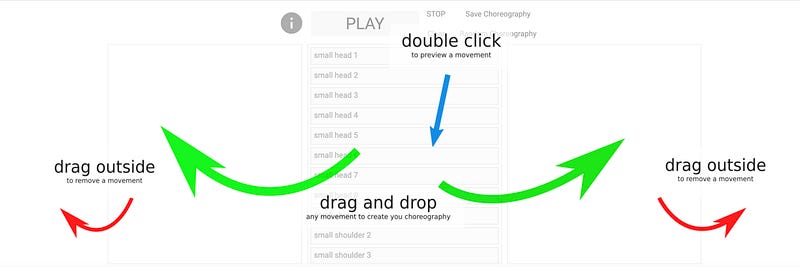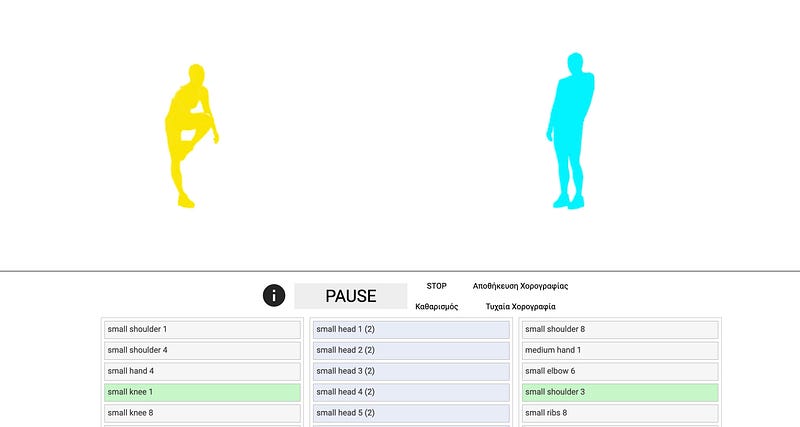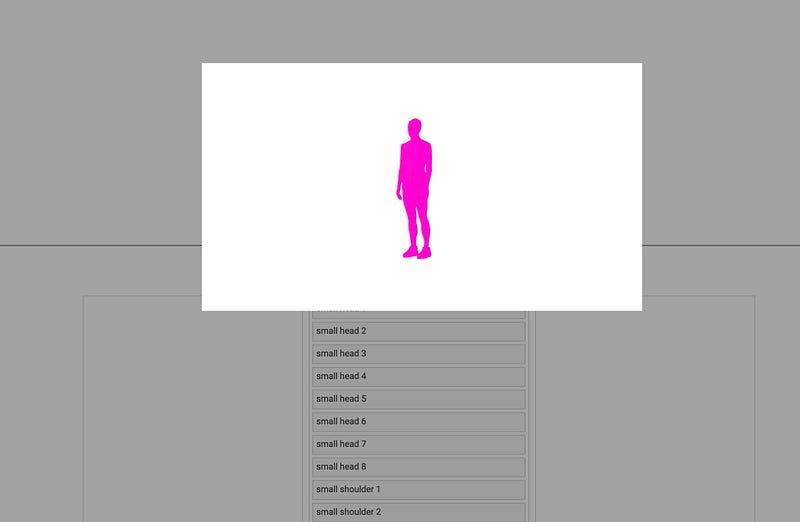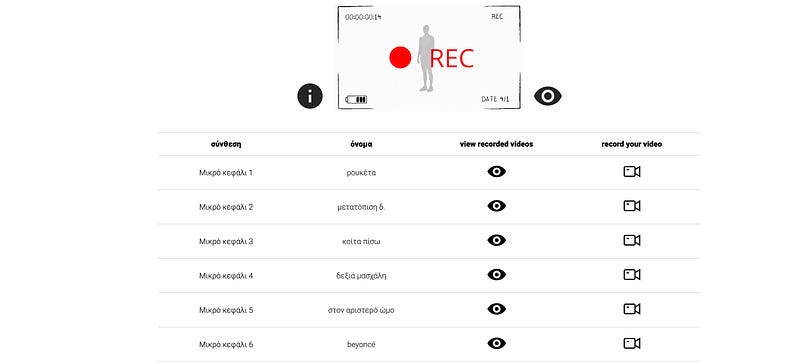09.01.2023
Hardly virtual: an interface to play with movement and think of choreography abstractly
Dance
Motion capture and the many different domains it has been implemented, such as cinema, game design, but also engineering, proves that the ability to abstract movement is a tool that goes beyond the art of dance. Rather, it demonstrates how abstraction requires to think of movement in a more philosophical sense, i.e., to occasionally think of choreography without a body. In his project hardly virtual [1], Dimitris Mytilinaios created an online interface where users could play with basic compositional tools and thus become potentially (or virtually) choreographers-performers.

Mytilinaios conceives choreography as a three-column table; the centre column contains the anatomical categorisation of movement, from head to ankle, providing the user with an inventory of bodily articulations which can be dragged and dropped to either left or right columns, re-ordered and processed according to one’s imagination, then pulled outside the column to create a choreographic phrase. However, this elemental three-step (input-sequencing-output) approach to choreography is suggesting more than a simplistic device to play with movement. Abstracting movement and attempting composition with(in) a virtual interface, may remind us that abstraction lies at the heart of choreographic thought and that choreography could also be achieved without real bodies. This is not a statement that could raise another ontological threat to dancing bodies or even express a burning debate about the world becoming increasingly flattened on screens; in fact, many philosophical approaches focused on how technological intervention has undermined or manipulated the subjective experience of body, its cultural representations and significations. Overcoming this fear of losing ‘sight’ of the embodied nature of movement demands that we reframe the very phenomenological approach to dancing, which centres the body as the basis of knowledge and experience. It demands actually to approach thought as the most abstract moment of experience and thus consider choreography as movement-thought.
As Stamatia Portanova notes in her book, Moving Without a Body 2, the virtual can be thought of as “an incorporeal potential for variation” and “this unlimited potentiality or infinitely multiple condition of experience is not equitable with any sensed or material continuity.” On this trajectory, hardly virtual interface might be considered a choreographic machine, one that approaches the body as a structured map of (some) possible articulations, which could be then organised into a number of combinations (not infinite). As it was the case with Merce Cunningham’s choreographic practice, hardly virtual seems to be about inorganic, non-sequential movement, with random transitions and no evident continuity; head, knee, ribs, elbow, pelvis, hand, ankle, are only points of departure for the many combinations to come. There is even a “chance” button, using an algorithm to create an aleatory composition, for those who are reluctant to participate mentally/actively in the making.

Hardly virtual is a choreographic machine which doesn’t produce a smooth, apparently fluid sequence of bits, but maintains the temporal cut from one movement articulation to the other, so much so that the body disappears in the cut, just like in early cinematography, when there might have been a glitch from one frame to the other. The comparison to cinema is not based on the fact that bodies where filmed before turning into colourful figures; rather, the comparison suggests focusing on the cut/montage technique as a perceptive mechanism. To make things even more peculiar or funny, in some cases the dancing figure is juxtaposed with a GIF background; sometimes it’s a school of sharks, an explosion of colours, or even a flock of birds. To link the above to Portanova’s reading of choreography as virtuality, would require first and foremost to inspect how the dancing body appears in thought: “rather than considering choreography as previous or successive moment of appropriation, forcing the body to adapt itself and its mysterious forces to the structures of thought, it is in thought that a movement, with both its qualitative and quantitative aspects, with its fluidity and extension in space and time, becomes a dance.”

A second feature of hardly virtual is dedicated to a more interactive use of the suggested body partition and the conceived choreographic tools; users are asked to orchestrate their “physical intelligence and kinetic imagination” to interpret the parameters they are given and then record their trials to contribute in the making of a “collective library” of movements. Movements are catalogued with their names/captions ―a modality which already indicates how abstraction and representation through language is a tool that could help the body regenerate or reenact the desired action, thus help the body think choreographically. Some names are indicative and descriptive of the action, like “right goes to the left shoulder”, others are more playful, like “gollum”, “mr. chin” or “i fuck diagonally.” The inventory of different interpretations recorded on video showcases how abstract data could be transformed into empirical, to create an archive of different approaches of the same movement. This imaginative-transformative feature carries also a substantial pedagogical dimension; it underlines how virtual knowledge or rather the virtuality of knowledge is constantly exposed to the instability of its own openness.

To reference once again Portanova, we could think of choreography as the virtuality of movement that materializes itself as it traverses the body. In other words, instead of thinking of the body as a purely mechanical tool for the execution of movement, we could somehow consider it as the technological apparatus through which a choreographic idea is implemented. Hardly virtual, in the above sense, isn’t merely about how (virtual) bodies respond to choreographic bits, but also how ideas might “look like” as they become embodied. It is a playful way to get into other people’s head by exploring their choreographic propositions―a reminder that choreography is not merely about the staged event, but a system of thought proposing its own visual articulations.
Anastasio Koukoutas is working in the field of dance theory, dramaturgy and writing. He studied (BA) Communication and Marketing at the Athens University of Economics, (MA) Performing Arts Administration at Accademia Teatro alla Scala (in collaboration with Bocconi University), Ethnomusicology at the National and Kapodistrian University of Athens (within the e-learning course Greek Music Culture and Education). He has worked, in the publishing field, as a contributor and editor, for art institutions and organizations, such as: Athens & Epidaurus Festival, Stegi Onassis, Dimitria Thessaloniki Festival, Megaron — The Athens Concert Hall et.al. He has worked as a dramaturg in theatre and dance performances (Athens Festival, Stegi Onassis, Experimental Stage of National Theatre in Greece, Arc for Dance Festival, Porta Theatre — Athens et.al.). He writes frequently about dance for the websites springbackmagazine.com, artivist.gr, und-athens.com, and teaches Dance History at the dance college ΑΚΤΙΝΑ. Last but not least, he has worked as a performer for Denis Savary (Lagune –National Museum of Contemporary Art, Athens — 2016), Virgilio Sieni (Biennale Danza / La Biennale di Venezia — 2016), Pierre Bal Blanc (documenta14–2017), Dora Garcia (Megaron, The Athens Concert Hall — 2018) et. al.
Dimitris Mytilinaios (SNF ARTWORKS Fellow 2019) has been active in the dance field since 2012. He is a graduate of the State School of Dance (2012–2015) and holds a Μaster exerce-ICI-CCN Université III Paul-Valéry-Montpellier- with a scholarship from Onassis Foundation, a two-year program directed by Christian Rizzo in the field of choreography.
[1] https://hardlyvirtual.dance/index.html The project is a natural ‘outcome’ of the work hardly the same: a dance guide to mess up body&mind, a duo with dancer Nefeli Asteriou, in which Mytilinaios initially researched and catalogued the basic principles of this virtual experiment. The website was programmed and designed by Yiannis Kranidiotis while the video clips with the two dancing figures were realised by Marina Skoutela (SuKu). hardly virtual has been also presented in the Athens Digital Arts Festival.
[2] Stamatia Portanova, Moving Without a Body — Digital Philosophy and Choreographic Thoughts, The MIT Press, 2013



